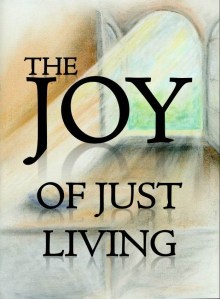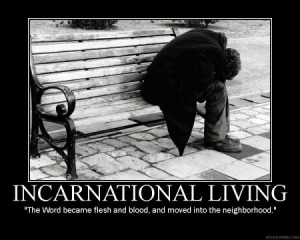 In all honesty, once it was on top and fully part of the establishment, the Church was a bit embarrassed by the powerless one, Jesus. We had to make his obvious defeat into a glorious victory that had nothing to do with defeat–his or ours. Let’s face it, we feel more comfortable with power than with powerlessness. Who wants to be like Jesus on the cross, the very icon of powerlessness? It just doesn’t look like a way of influence, a way of access, a way that’s going to make any difference in the world. We are such a strange religion! We worship this naked, bleeding loser, crucified outside the walls of Jerusalem, but we always want to be winners, powerful, and on top ourselves . . . at least until we learn to love the little things and the so-called little people, and then we often see they are not little at all, but better images of the soul.
In all honesty, once it was on top and fully part of the establishment, the Church was a bit embarrassed by the powerless one, Jesus. We had to make his obvious defeat into a glorious victory that had nothing to do with defeat–his or ours. Let’s face it, we feel more comfortable with power than with powerlessness. Who wants to be like Jesus on the cross, the very icon of powerlessness? It just doesn’t look like a way of influence, a way of access, a way that’s going to make any difference in the world. We are such a strange religion! We worship this naked, bleeding loser, crucified outside the walls of Jerusalem, but we always want to be winners, powerful, and on top ourselves . . . at least until we learn to love the little things and the so-called little people, and then we often see they are not little at all, but better images of the soul.
Yes, those with mental and physical disabilities, minority groups, refugees, the addicted, the homosexual, the prisoner–anybody who’s failed in our nicely constructed social or economic success system–can be our best teachers in the ways of the Gospel. They represent what we are most afraid of within ourselves, what we most deny within ourselves. That’s why we must learn to love our “enemy”; we absolutely must or we will never know how to love our own soul, or the soul of anything. Please think about that until it makes sense to you. It eventually will, by the grace of God.
One of the most transformative experiences is entering into some form of lifestyle solidarity with the powerless. It’s like changing sides from the ego side of things, and this  is what changes you. We don’t think ourselves into a new way of living; we live ourselves into a new way of thinking. It is lifestyle choices that convert people. I am not aware that merely believing a doctrine or dogma has ever converted anybody. That should be obvious by now.
is what changes you. We don’t think ourselves into a new way of living; we live ourselves into a new way of thinking. It is lifestyle choices that convert people. I am not aware that merely believing a doctrine or dogma has ever converted anybody. That should be obvious by now.
Someone once pointed out to me that most of the great founders of communities, including Francis of Assisi, Mother Katherine Drexel, Vincent de Paul, Benedict, John Baptist de la Salle, and Mother Seton all started out as what we would now call middle class or even upper class. They first had enough comfort and security and leisure to move beyond their need for more comfort and security and leisure (because they saw it did not satisfy or feed the soul). Each in their own way changed sides and worked in solidarity with those who did not have their advantages.
-Fr. Richard Rohr
Like in the story of the Good Samaritan: The outcasts, weak, addicted, afflicted ar e our life mentors. Broken people and people from outside the margins…that is where interpretation needs to come from. We think that we are going to them to help them but the thing that happens is that they teach us. They are so much closer to surrender and we still have so much stuff to let go of before we can get to that place of surrender where we can let go of everything. -Walter Brueggemann
e our life mentors. Broken people and people from outside the margins…that is where interpretation needs to come from. We think that we are going to them to help them but the thing that happens is that they teach us. They are so much closer to surrender and we still have so much stuff to let go of before we can get to that place of surrender where we can let go of everything. -Walter Brueggemann
You must be logged in to post a comment.